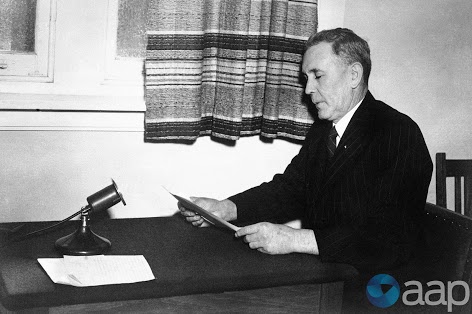The Statement
AAP FactCheck examined a Facebook post from October 4, 2019 by an Australian user which features a claim that a Liberal-National Party (LNP) government transferred $170 billion from an ‘Aged Pension Trust’ into the Future Fund.

The post reads: “Hey Peter Costello…head of the Future Fund since 1939 7% of Aussie taxpayer funds went into the ‘Aged Pension Trust’ for all Australians. The LNP transferred $170 BILLION from the Pension Trust into the Future Fund which covers retirement benefits for Public Servants and Politicians ONLY nice rort, Peter”.
Text accompanying the post reads: “Pension is NOT WELFARE”.
The post has been shared more than 460 times and attracted more than 40 reactions on Facebook.
The Analysis
Professor Peter Whiteford from the Australian National University’s Crawford School of Public Policy told AAP FactCheck the claim “is a longstanding ‘myth’ i.e. there is an element of fact behind it but overall it is not correct”.
Prof Whiteford has done extensive research on Australia’s social security system, was a former adviser in the office of the Minister for Social Security from 1995-96 and has also done consulting work on social security with Australian and UK universities and with the Organisation for Economic Cooperation and Development (OECD).
“There was a National Welfare Fund established in 1943 as part of the introduction of new social security measures in Australia,” he told AAP FactCheck in an email.
“From 1945/1946 there was also a Social Services Contribution, which was in fact no more than an extra tax on income and was merged with income tax five years later.”

The National Welfare Fund was introduced in 1943 by Ben Chifley, who was treasurer in John Curtin’s Labor government.
A 1985 paper by I. Scott, of the Education and Welfare Group in the Australian Parliamentary Library, states on page 2 that the fund was established with the smaller of either £30 million (this is in pre-decimal currency Australia) drawn from consolidated government revenue or one quarter of individual income tax receipts.
In 1945 Chifley, then prime minister, split income tax into two parts to create a separate levy to finance social security payments. The Parliamentary Library paper states on page 4 that this separate levy “created a mistaken belief in some quarters that the social services were thereby placed on a contributory basis”. A contributory system is one where people pay into a system over time to fund their future entitlements.
In its 1988 yearbook the Australian Bureau of Statistics notes that the levy went into the National Welfare Fund, along with supplements from payroll tax and general revenue “but there was no link between personal contributions and entitlements“.
David Stanton, from the Crawford School of Public Policy at the Australian National University and a former senior official in the Department of Social Security told AAP FactCheck the “7% of Aussie taxpayer funds” aspect of the claim most likely came from the maximum rate of social services contribution in 1946, which was one shilling and sixpence in the pound – equal to 7.5 per cent.
The tax imposed ranged between three pence per pound for a single person earning above 104 pounds per year, or 1.25 per cent, and up to one shilling and sixpence per pound for those earning 220 pounds, or 7.5 per cent.
A Department of Social Security spokesperson confirmed to AAP FactCheck the term “Aged Pension Trust” was a colloquial term used to refer to the National Welfare Fund.
Regarding the date of 1939 that appears in the Facebook post, the Crawford School’s Mr Stanton told AAP FactCheck some people confuse the National Welfare Fund with a “contributory National Insurance Scheme legislated in 1938”.
“Although the legislation was passed the scheme never came into effect. The introduction was deferred and then repealed in 1939,” he said.
In 1950 the Menzies government rolled the separate levy and income tax into one and the National Welfare Fund was no longer funded from a separate contribution.
In 1952 changes were made that meant money flowing out of the fund was replenished from consolidated revenue and, according to page 6 of the Scott paper, “the Fund ceased to have any direct relationship with tax collections and thus with any prospective or possible contributory scheme to finance social security”.
In 1976, during debate on the bill that transferred the book balance of the National Welfare Fund into consolidated revenue, Minister for Industry and Commerce Senator Bob Cotton told parliament that the 1952 change meant “all social security payments are met from the Consolidated Revenue Fund, even though moneys are still channelled through the National Welfare Fund Trust Account”.
In 1985, under the Hawke Labor government, federal parliament passed a bill to repeal the National Welfare Fund Act 1943 and “to make all relevant social service payments directly from the Consolidated Revenue Fund“.
Prof Whiteford said the National Welfare Fund ended in 1985, “well before the Future Fund”.
The Future Fund was established in 2006 by Liberal Treasurer Peter Costello and Finance and Administration Minister, Nicholas Minchin, to cover unfunded Commonwealth government superannuation liabilities.
A Future Fund spokesperson told AAP FactCheck funding from government came from “a combination of Budget surpluses and the transfer of Telstra shares remaining after the third stage of the privatisation of Telstra”.
“The Fund received no funding from any other source,” the spokesperson said.
Beginning in May 2006, the government transferred credits into the Future Fund using money from the budget surplus, and in 2007, it began transferring Telstra shares into the Fund. The last government transfer into the Future Fund was in 2008 under the Rudd government which transferred 35 million Telstra shares worth $141 million. The overall government contribution to the Future Fund was more than $60.5 billion which was made from 2006 to 2008.
The Future Fund invests to receive a return and build its assets. In a 2018 speech, Future Fund Chairman Peter Costello said the $60.5 billion “has grown to just under $149bn, that is, the Future Fund has made the Government $88bn. This represents investment returns since inception of 7.9% pa.”
The highest cash balance in the Future Fund recorded was $162 billion from 2018-19 which resulted from the Fund’s investment returns.
The Verdict
Based on the evidence, AAP FactCheck found the Facebook post to be false. The National Welfare Fund, referred to colloquially as an Aged Pension Trust, did not receive seven per cent of taxpayer funds from 1939. The fund was abolished more than 20 years before the Future Fund was established. An LNP government did not transfer $170 billion from the National Welfare Fund to the Future Fund. The Future Fund was funded by budget surpluses and proceeds from the third and final phase of the privatisation of Telstra.
False – The primary claim of the content is factually inaccurate.
* AAP FactCheck is an accredited member of the International Fact-Checking Network. To keep up with our latest fact checks, follow us on Facebook, Twitter and Instagram.
First published October 18, 2019, 14:51 AEST

















